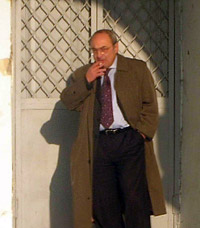Vazgen Manukyan will most probably announce his decision to not participate in the upcoming parliamentary elections and this will signal the end of the Ter-Petrosyan era. It is not hard to guess what Vazgen Manukyan’s possible announcement has to do with the end of Ter-Petrosyan’s era, if the issue is observed in the context of political systems.
With Armenia’s declaration of independence in 1991 and the formation of the liberal government, a political system was formed in Armenia with the Armenian National Movement (ANM) [liberalists] on one side, the Dashnaktsutyun [socialist-nationalists] on the other side and the National Democratic Union (NDU) [liberal/nationalists] in the center. The Armenian Communist Party was somewhere along the lines. The existence of the once powerful political party was conditioned by the nostalgic moods growing parallel to the “painful” liberal reforms, but both the party suffering from nostalgia and their leaders understood very well that reforms could not be circumvented. In that case, the Communist Party could only restrain itself if, of course, it were able to go through reforms by leaving Lenin and Stalin behind and moving towards Marx and Engel; in other words, make the beginning of the movement and its ideas correspond to the national strives and desires. Meanwhile, we Armenians remember the meetings and demonstrations of the Communists with their red Soviet flag and portraits of Lenin.
Being older than the Armenian National Movement with the history of the National United Party and not the advantages of being an organizational and constructive party, the National Self-Determination Union, or the movement led by Paruyr Hayrikian had already ceded to the “Karabakh” Committee in 1988 and the Armenian National Movement in 1990 and only survived with its glorious history in the political field of Armenia. If we examine the ideas (with a few exceptions), the National Self-Determination Union was the repetition of the Armenian National Movement and vice versa.
There were also marginal groups within this political system, for example the Constitutional Rights’ Union, the Republican Party, which was the continuation of the national wing of the abovementioned National United Party (at least during the time of the late Ashot Navasardyan), the Christian Democratic Party that could have been with the National Self-Determination Union (NSDU) but in the end stuck with the Armenian National Movement (ANM). The first three parties were more active during the war. The ANM was the authorities, the ARF was the opposition, NDU could go with the ARF during the movement and then take on governmental duties with the ANM (leader of NDU was the Defense Minister).
One political activist who at the time was a member of the ARF and then left the political party (I am not mentioning his name due to security reasons), said that there was serious cooperation between the three powers during those years. According to him, there were public meetings and protests that were organized upon the request of the government in order to make outsiders get the impression that there is a strong, internal resistance. The crisis of the ANM or the Ter-Petrosyan era reached its peak when the role of the ANM did not satisfy the Dashnaktsutiun and the latter tried to do everything it could (by all means) to take control. This strive of the Dashnaktsutiun was going to misbalance the political system, lead to polarized groups formed by incomprehensive principles and in the end, it would lead to the collapse of a political and, in my opinion, a rather vital system.
The political system of Armenia was new and there was a higher possibility to be allured in such conditions. The Dashnaktsutiun was inspired by the efficiency of some armed forces; it thought that it could organize a state overturn quickly without any casualties and seize power. It wanted to take control of Armenia (recently one of the Dashnaks confessed that Ter-Petrosyan had proposed to them the ministry positions that they have now) because it believed that the ANM government had been distracted from the national, as we shall say, ideology. The revelation of the Dashnaktsutiun’s intentions was also a great way to allure the then existing authorities. The ANM members thought that that way it would be easier to fortify the unit power, lead the reforms to an end without facing any obstacles, start peaceful negotiations by excluding the national element in internal life.
The ANM-ARF conflict allured the NDU. The NDU members thought that by having the support of the ARF while the conflict is gong on, NDU could easily seize power. In that case, only Vazgen Manukyan could have become president because the ARF didn’t have any prominent leaders-neither in 1991, later or even now.
To be continued…

